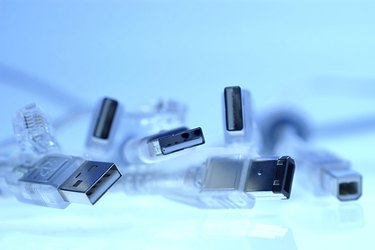
If your previous printer purchases all consisted of hardware that connected through parallel ports and cables, adding a new HP printer to your roster of equipment may serve as your introduction to USB output devices. Before you get ready to take the printer out of its box and set it up, verify that you have the right kind of USB cable at the ready. Without proper connections, your printer is just an expensive paperweight.
Cables & Hubs
Video of the Day
As of June 2013, current HP USB printers connect using cables that can handle USB 2.0 connection speeds, which top out at 480 Mbps. The USB specification limits cable length to 16 feet to prevent data timing errors. If you want to connect your HP printer through a hub, the specification further limits the data distance between device and computer to five nodes, each of which constitutes a hub, switch, or a repeater used to boost the signal and extend cable length. Some HP printers won't operate properly if they share a USB data network with output devices from other manufacturers, so your best bet may be a direct printer-to-computer connection with no other intervening hardware.
Video of the Day
Connectors
USB cables come with a variety of connectors. The connection between a USB printer and a computer uses a cable with an A-type connector on one end and a B-type connector on the other. The A-type connector features a flat rectangular plug. A white plastic piece blocks half the height of its opening, forcing it to match up with the corresponding port in only one orientation. The B-type connector features a roughly square opening, but its trapezoidal shell determines its orientation relative to its port.
Computer & Printer Connections
The asymmetrical connectors on a USB printer cable automatically tell you which end plugs in to which device. The flat A-type connector plugs in to your computer or hub. The square B-type connector matches up with the port on your printer. Both Microsoft Windows and Mac OS X include built-in support for many output devices. Before you cable up the device, check its installation instructions to verify whether you must install printer driver software before connecting your hardware. If you fail to follow these directions, you may need to uninstall the driver and reinstall it.
Other Considerations
Many HP printers ship without USB cables among their supplied accessories. Read the product description thoroughly before you buy, especially if you purchase your printer from an online merchant, to verify whether you must add on a cable to complete your acquisition. If you plan to reuse a cable that came with or from an older printer, check its compliance with the generation of the USB specification that your printer uses. If you try to implement a USB 1.0 cable on a USB 2.0 device, you may see unexpected or failed output results.
- The Spill: Serial Vs. Parallel Vs. USB Vs. Ethernet Vs. Wireless Printer Connections
- Tech Ease Win: What Is USB?
- University of Wisconsin DoIT Showroom Buyer's Guide: USB, Firewire, eSATA Connectors Guide
- Creighton University: A Guide to Computer Ports
- USB Cable: USB Cables
- HP: HP Deskjet Printers -- What Is the Difference Between a USB and Parallel Cable?
- HP: Smart Install FAQ
- HP: Windows 8 Printer Drivers
- HP: Printer Install Issues with Windows 8
- HP: FAQs About Printer Installation
- HP: USB Printer Installation Troubleshooting
- Windows: How to Solve Printing Problems in Windows
- Apple Inc.: OS X Mountain Lion: Troubleshoot a USB Printer